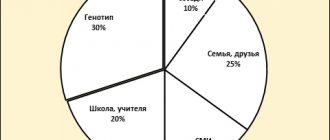Definition of the word “Indeterminism” according to TSB:
Indeterminism (from the Latin in - a prefix meaning denial, and Determinism) is a philosophical doctrine and methodological position that denies either the objectivity of the causal relationship (ontological I.) or the cognitive value of a causal explanation in science (methodological I.). In the history of philosophy, starting from ancient Greek philosophy (Socrates) up to the present time, philosophy and determinism appear as opposing concepts on the problems of the conditionality of the human will, his choice, and the problem of human responsibility for his actions. I. interprets will as an autonomous force, argues that the principles of causality are not applicable to explaining human choice and behavior, and accuses supporters of determinism of fatalism. Marxism proceeds from the fact that “determinism not only does not imply fatalism, but, on the contrary, it provides the basis for rational action” (Lenin V.I., Poln. sobr. soch., 5th ed., vol. 1, p. 440), “... does not in the least destroy either the mind, or the conscience..., or the assessment... of the actions” of a person (ibid., p. 159) (see Art. Free Will). Various forms of philosophy have become widespread in modern bourgeois philosophy. Thus, the Baden school of neo-Kantianism limited the principle of determinism only to the field of natural sciences and denied its applicability to the “spiritual sciences” (W. Windelband, G. Rickert). Neopositivism, Pragmatism and Personalism try to limit determinism to the logical sphere only. The problem of quantum physics and determinism has become especially relevant in connection with the development of modern quantum physics. It was found that the principles of classical determinism are not suitable for characterizing the processes of the microworld. In this regard, attempts were made to interpret the basic laws of quantum theory in the spirit of I. and agnosticism. At the same time, one of the historical forms of determinism, namely mechanistic determinism, was identified with determinism in general. Difficulties in understanding the problems of causality in modern physics have resulted in the strengthening of tendencies towards causality in modern bourgeois philosophy. Thus, B. Russell, H. Reichenbach, F. Frank argue that determinism had no scientific value at all; the axiom of causality, in their opinion, is not even part of classical physics, because the statement of causality cannot be reduced to the relationship between observables facts, since the measurement results are in the nature of a probability distribution. The expression of I. were the ideas about the “free will” of the electron, that individual micro-phenomena are controlled by teleological forces, etc. Dialectical materialism, rejecting I., at the same time shows the insufficiency of previous mechanistic ideas about determinism and, based on the achievements of modern natural and social sciences forms a new generalized idea of determinism. Lit. see under Art. Causality. A. P. Ogurtsov.
What are the determinants of psychological development?
There are several such determinants, and all of them are factors that influence how a personality develops and what manners it acquires.
The following determinants are distinguished:
- Genetic predisposition , which consists not only in hereditary diseases, primarily mental, but also in the repetition of actions similar to those carried out by close people.
- Environment , which also influences the formation of a person through the conditions in which he resides.
- Confrontation with the environment is a departure from generally accepted norms and stereotypes, conditioned by volitional qualities and manifested in voluntary actions.
- The development of the psychological component of a personality manifests itself when a level of development has been reached (this applies to knowledge, skills, talents) that begins to contradict reality.
Dialectical materialism as determinism
Most nineteenth-century philosophers believed that the structure of society and its specificity were determined by the ideas it shared. Ideas and reason, from their point of view, ruled the world. At the same time, Marx, as well as his supporters and followers, decided to approach the problem from a different angle. They declared the main factor determining social development to be material. That is, the fact that people, in the process of working together, produce the means of living, represents the foundation of society. They determine all other types of human activity, as well as their social, psychological, and spiritual activity. Moreover, any morality, religion, etc. are just a reflection of material life, and if they have some kind of independence, it is only relative. The theory of determinism in this presentation focused on the role of the economic factor and its dominance. However, in the modern world these concepts are no longer defining.
Formation of a deterministic view in the ancient period
Understanding the causality of certain phenomena appeared in the ancient period among ancient peoples. This was facilitated by the development of political and public life, especially in Ancient Greece. Views about causation were expressed by Democritus and Leucippus.
In ancient India, ideas of cause and effect were closely related to karma and rebirth. Here, one can observe the relationship between a person’s behavior and his quality of rebirth in a future life.
In Ancient China, Lao Tzu studied deterministic processes especially carefully. He called this process “Tao”. It exists constantly, in everything and everywhere. Tao represents inaction, does not depend on time, creates the universal unity of the world.
The formation of the deterministic direction originates in Ancient Greece. Ancient philosophers, in their works, examined in detail the laws of the world. It was called differently: “nike”, “logos”, “homeomerism”, “nous”, “atoms”, “chance”, “vortex”, four types of cause according to Aristotle.
Non-causal types of determination
Causeless phenomena do not exist. But this does not mean that all connections between
phenomena in the surrounding world are considered cause-and-effect. How
emphasized above, causality is the most essential and universal, but by no means
not the only type of determination. Along with causality (and in relative
unity with it) such very significant types of determination are also revealed,
as a functional connection, a correlative connection, a connection of states.
Consideration of these types of determination is typical only for
postclassical science and postclassical philosophy. It’s clear why: after all,
classical science (and, accordingly, philosophy) was dominated by Laplace's
determinism with its absolutization of a dynamic unambiguous cause.
3.1. Functional connection
The great merit of postclassical science and philosophy is, in particular, their
close attention to the functional type of determination. Wherein
functional connection is understood as such a relationship between objects,
in which changes in each of them accompany each other. Exactly
“accompany” and not “cause” each other. As a rule, objects located
among themselves in functional interaction, are connected genetically (causally)
only in the sense that they are derivatives of the same base. IN
the functional connection of objects itself lacks the main features
cause-and-effect relationship - productivity (objects do not produce each other
each other), asymmetry in time (they coexist, one of them does not
precedes another), irreversibility.
Let's try to distinguish between causal and functional connections
illustrate with this example. Some philosophical schools, wanting
explain the tragedies of the twentieth century (two world wars, bloody
revolution), associate them with the emergence at the end of the 19th, and especially in the twentieth century,
to the forefront of the history of radically minded, but insufficiently cultured
the masses. There is no doubt that the masses are entering the sphere of active historical
creativity is accompanied by significant and long-term sociocultural
costs, although in general it is a progressive phenomenon. But
it is impossible to consider the active activity of the masses as the cause of these
tragedies: this very entrance of the masses to the forefront of history was a consequence
the inhumane course of social development unacceptable to them.
Consequently, between these tragedies and the unprecedented activity of the masses
The relationship is not cause-and-effect, but functional.
3.2. Correlative connection
In many respects, a correlative connection
- mutual dependence of phenomena, revealed in their correlation, in their
correspondence to each other. As well as functional, correlative connections
the essence of the connection of coexistence, simultaneity; as well as functional, they,
without being cause-and-effect, at the same time they assume “ahead of themselves”
some general reason leading to such correlation, correspondence. But
if the functional connection is usually more or less transparent, and its
the basis is revealed without any special difficulties, then with correlative connections such
“clarification” is complicated by the presence of a number of related phenomena
intermediate, mediating factors. Thus, it has long been noted that
completely white cats with blue eyes always or almost always turn out to be
deaf, but it became possible to explain such a correlation only today,
based on the laws of genetics.
Correlative connections in general were first discovered in biology - J. Cuvier, and
then by C. Darwin. Darwin interpreted his “law of growth ratio” as
the law according to which the known forms of the individual parts of an organic
beings are always connected with certain forms of other parts, not
seemingly in no connection with the former. “It would seem” - because on
in fact, there are, but this connection is veiled and still needs to be revealed.
Today, correlative, correlative connections are studied by many sciences, and
knowledge about them is not only purely theoretical, but also widely applied
meaning (including used in technology).
3.3. State connection
Every object has at least two types of relationships:
the interaction of a given object with other objects and the relationship of different
states of the same object[6]. This
different relationships. The interaction of an object with other bodies is dynamic
(force) character, causes its changes and is therefore the cause.
The state of the body at a given moment, although it influences the state of this body in
the subsequent point in time is not causal in nature.
What element of determination expresses in this case the preceding
state of an object in relation to its current state? Obviously so
the element expressing the essence of the connection between states is the condition
whose role in the determination complex has already been discussed. Such a conclusion is in no way
at least is not a concession to so-called conditionalism -
teaching,
which confuses conditions with cause, identifies them, and in some of its
options, it even simply replaces the conditions with the reason.
So, the previous state acts as a factor that determines
only the generation itself by specific causes of the subsequent state of the object,
but also many characteristics of this state (its shape, scale, temporary
parameters, etc.).
We feel a natural connection between states today, being involuntary
witnesses (and many are active participants) of what is happening in Russia
changes. The pre-perestroika state of society has not sunk into oblivion; it is largely
determines the limits of reformation possible today. Firstly, it is saved
a type of mass consciousness characteristic of the previous state of society. In-
secondly, the comparison of the two states is not in favor of the reforms that have begun -
previous and present - according to many important existential characteristics
(confidence in the future, level of material well-being
majority, degree of social protection, etc.). If we take it even more broadly,
then everything accumulated in the previous states of Russian history, everything
our sociocultural heritage determines the image of today's changes.
Description of probabilistic determinism
After unambiguous determinism, a theory of probabilistic causation of phenomena appeared. Its appearance coincides with the peak of development of theories about thermodynamics and statistical physics. The concept of hard causality, over time, showed its imperfection, especially when probabilistic methods and research theories appeared. Statistical patterns were primary; they became the beginning of models of the probabilistic world. The probabilistic method of study undermines the authority of unambiguous causality, the main idea of which is: external causes are omnipotent.
Hobbes, Descartes and other enlighteners
Mechanistic determinism is an attempt to equate living beings with automata. All bodies are things. They move, have shape, quantity, extension. Their movements consist of pushes and forces. Some of them are animate (that is, they have sensations that reflect all this, memory, the ability to compare). This is how Thomas Hobbes saw our world. Rene Descartes prefers causal, logical determinism, separating matter from spirit. He provides the latter with creative energy, but binds his thinking with special laws. The matter from which the world consists is a clockwork mechanism once wound up by God, in which, naturally, all the cogs depend on each other. Almost all famous figures of the French Enlightenment shared this point of view to one degree or another.
Historical stages
One of the earliest versions of this concept known to us was the teaching of Democritus. Any freedom, the philosopher believed, Almost every overweight person dreams of losing weight. And most often it starts with choosing a diet. Some people have the willpower to keep it up for a long time, and they manage to lose a few kilograms. Someone quits, and after a while goes on a new diet. What is the reason for this behavior? This is just the opinion of mortals. A reasonable person sees at the root of things and understands that everything in the world is atoms and emptiness. But Epicurus assumed a certain freedom even in the movements of atoms. Democritus believed that there is nothing like this, and especially accidental. We just don’t see the connection and necessity between some phenomena, and they look that way to us.
The concept of determinism in this form is called mechanistic. In a more or less developed form, it existed until the beginning of the nineteenth century. Its popularity flourished in the seventeenth and eighteenth centuries.
Foundations of modern determinism
Already in the 20th century, a new model of ideas about the universe began to form. In the mid-twentieth century, a new idea about synergetics appeared, and the physical and mathematical foundations of self-organization phenomena were developed. Modern determinism is a combination of individual ideas of all ideas about causality, starting from the ancient period. The new approach derives three categories of time dependence of cause and effect:
- the cause appears first, then the effect, strict sequence - this is the classical model;
- there is a gap between cause and effect, but they are closely connected by the conditions of short-range action, the final speed;
- cause and effect appear simultaneously: when the process of cause is just beginning, its effect immediately arises, then the cause is “extinguished” by its effect.
Representatives of determinism and indeterminism
The development of determinism occurs from antiquity to the present day. During this time, many philosophers, physicists and scientists became devoted determinists, studying different categories of this view of the organization of the world. Among other representatives of determinism, the most significant contribution was made by the works of Montesquieu. This is the originator of the concept of geographical causality. In his works, he describes in detail the influence of climate on some characteristics of peoples.
A proponent of univocal determinism was Pierre-Simon Laplace. His ideas were the starting point for supporters and opponents of the world organization model. His concept was supported and complemented by L.I. Mechnikov, E. Huntington and others. The classification of forms of causality was determined by Mario Bunge. Actively developed the idea of cause and effect in physics: Maxwell, Lagrange, V.A.Fok.
Representatives of the modern view of determinism as a synegretic concept are V.P. Bransky, V.V. Mantatov, D. Blokhintsev, K. Nikolsky and others.
Determinism and indeterminism are two completely opposite philosophical movements in the field of the role and place of causality. Followers of determinism are confident in the objective nature of causality. Proponents of indeterminism, on the contrary, completely deny objective causation, and causation in general.




